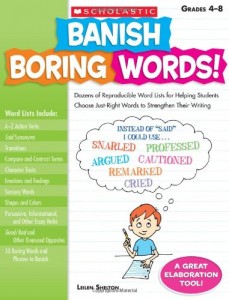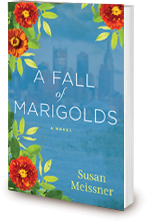Writers need to have books nearby. Some are reference books and some may be for inspiration. Recently, children’s author Lynda Pflueger blogged about organizing her desk for writing. She began by clearing off unnecessary books:
 After looking over my choices, I determined I needed five reference books on my desk: The Synonym Finder by J. Rodale’s; A Pocket Style Manual by Diana Hacker; Roget’s Descriptive Word Finder by Barbara Ann Kipfer; Banish Boring Words! by Leilen Shelton; Longman Dictionary of Contemporary English.
After looking over my choices, I determined I needed five reference books on my desk: The Synonym Finder by J. Rodale’s; A Pocket Style Manual by Diana Hacker; Roget’s Descriptive Word Finder by Barbara Ann Kipfer; Banish Boring Words! by Leilen Shelton; Longman Dictionary of Contemporary English.
I, too, love Rodale’s The Synonym Finder. It’s an indispensable writing tool for me. When I taught high school writing, I once told a student who was stuck using the same word over and over again that there was a thesaurus behind him. Much to his embarrassment, he jumped up and looked around. He must have thought a thesaurus was a relative of the Stegosaurus!
I asked Regency romance author Judith Lown for her favorite writer’s book. Here is her contribution:
I’ve read a number of books and articles that have inspired me about being a writer. But the book that has been of most practical help to me is A Writer’s Book of Days by Judy Reeves. I have used the daily writing exercises in this book to dissolve writer’s block, organize the logistics of complicated scenes, and decide plot questions. I cannot recommend it more strongly.
Other titles I keep close at hand for reference include:
- The Chicago Manual of Style, 16th ed. Chicago: University of Chicago Press, 2010
- Merriam-Webster’s Collegiate Dictionary, 11th ed. Springfield, MA: Merriam-Webster, 2003
I have both print and online access to both. These books are standard references in the publishing industry and at eFrog Press all of our editors use them.
When editing or writing fiction, I frequently reference The Emotion Thesaurus: A Writer’s Guide to Character Expression. I have the ebook on my tablet so I can quickly look up an emotion and find a selection of descriptions and actions for the character experiencing that emotion. For example, if the character is curious, I have pages of options in categories for physical signals like tilting the head to the side, internal sensations like an increased pulse, mental responses like increased awareness of sensory information, cues like fidgeting or tics, and many examples in each of these categories! Such details help you bring your characters to life.
For Inspiration
 Sometimes you just need a beautifully written book at hand to inspire your own prose. For a while, that book was The Elegance of the Hedgehog by Muriel Barbery. The author wrote: ”I find there is nothing more beautiful, for example, than the very basic components of language, nouns and verbs.” Her powerful use of basic language inspires me to do the same. Currently, I take my inspiration from Susan Meissner’s descriptions in Secrets of a Charmed Life. Read this introduction to her main character in the first chapter:
Sometimes you just need a beautifully written book at hand to inspire your own prose. For a while, that book was The Elegance of the Hedgehog by Muriel Barbery. The author wrote: ”I find there is nothing more beautiful, for example, than the very basic components of language, nouns and verbs.” Her powerful use of basic language inspires me to do the same. Currently, I take my inspiration from Susan Meissner’s descriptions in Secrets of a Charmed Life. Read this introduction to her main character in the first chapter:
Isabel MacFarland steps into the room. She is a wisp of tissue-thin, weightless white hair, and fragile-looking bones. She is impeccably dressed, however, in a lavender skirt that reaches to her knees and a creamy white blouse with satin-covered buttons. Black ballet flats embrace her slender feet. A gold necklace rings her neck. Her nails are polished a shimmery pale pink and her cottony hair is swept up in the back with a comb of mother-of-pearl. She carries a fabric-wrapped rectangle, book shaped and tied with a ribbon.
Got to love “wisp of tissue-thin, weightless white hair, and fragile-looking bones” and “Black ballet flats embrace her slender feet.” So when my writing feels flat or I get stalled, I read a few pages and remember what I aspire to do.
Please Share
What titles do you keep near when writing? Are they for reference, inspiration, or both?
 Since I founded eFrog Press almost four years ago, I have worked with dozens of authors and am always intrigued by their individual writing processes. No two authors seem to have the same process. I think writers have more rituals than major league baseball pitchers although there is less scratching and spitting involved.
Since I founded eFrog Press almost four years ago, I have worked with dozens of authors and am always intrigued by their individual writing processes. No two authors seem to have the same process. I think writers have more rituals than major league baseball pitchers although there is less scratching and spitting involved. Authors can take a page from
Authors can take a page from